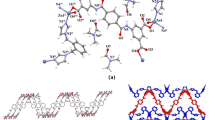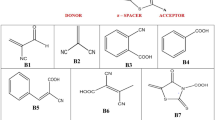Abstract
The replacement of heavy metals used by industry to produce optical devices would considerably reduce the environmental and economic cost of man-made technology. A possible strategy relies on the employment of lighter and more abundant metals like iron. The exploitability of the photophysics of Fe(II) complexes is, however, generally limited by their short excited-state lifetimes and poor emission properties. The present work studies the impact of appending an electron acceptor (anthracene) to N-heterocyclic carbene (NHC) iron complexes with the aim to trap the excited-state energy and, therefore, delay the excited-state decay of the considered iron compounds. Hence, the photophysical properties of six prototypes (built with different spacers between the NHC ligand and the anthracene moieties) have been studied by using time-dependent density functional theory and by determining the natural transition orbitals of the excited states. The computational results suggest that ethynyl bridges induce dual absorption properties, covering red and infrared wavelengths in addition to the violet–blue absorption of the metal-to-ligand charge transfer band, already reported for the parent compound. The nature of the lowest lying triplet states indicates that, for all the considered prototypes, the excitation involves π* orbitals localized over anthracene, confirming its electron acceptor capabilities and suggesting a possible equilibrium between different excited states that might lead to enhanced excited-state lifetimes and/or boosted luminescence properties.









Similar content being viewed by others
References
Wenger OS (2018) Photoactive complexes with earth-abundant metals. J Am Chem Soc 140:13522–13533. https://doi.org/10.1021/jacs.8b08822
Barbieri A, Accorsi G, Armaroli N (2008) Luminescent complexes beyond the platinum group: the d10 avenue. Chem Commun. https://doi.org/10.1039/B716650H
O’Regan B, Grätzel M (1991) A low-cost, high-efficiency solar cell based on dye-sensitized colloidal TiO2 films. Nature 353:737–740. https://doi.org/10.1038/353737a0
Browne WR, Feringa BL (2006) Making molecular machines work. Nat Nanotechnol 1:25–35. https://doi.org/10.1038/nnano.2006.45
Colasson B, Credi A, Ragazzon G (2016) Light-driven molecular machines based on ruthenium(II) polypyridine complexes: strategies and recent advances. Coord Chem Rev 325:125–134. https://doi.org/10.1016/j.ccr.2016.02.012
Kalinowski J, Fattori V, Cocchi M, Williams JAG (2011) Light-emitting devices based on organometallic platinum complexes as emitters. Coord Chem Rev 255:2401–2425. https://doi.org/10.1016/j.ccr.2011.01.049
Wenger OS (2019) Is iron the new ruthenium? Chem Eur J. https://doi.org/10.1002/chem.201806148
Bressler C, Milne C, Pham V-T et al (2009) Femtosecond XANES study of the light-induced spin crossover dynamics in an iron(II) complex. Science 323(80):489–492
Zhang W, Alonso-Mori R, Bergmann U et al (2014) Tracking excited-state charge and spin dynamics in iron coordination complexes. Nature 509:345
Kjaer KS, Kunnus K, Harlang TCB et al (2018) Solvent control of charge transfer excited state relaxation pathways in [Fe(2,2′-bipyridine)(CN)4]2−. Phys Chem Chem Phys 20:4238–4249. https://doi.org/10.1039/C7CP07838B
Chábera P, Kjaer KS, Prakash O et al (2018) FeII hexa N-heterocyclic carbene complex with a 528 ps metal-to-ligand charge-transfer excited-state lifetime. J Phys Chem Lett. https://doi.org/10.1021/acs.jpclett.7b02962
Monat JE, McCusker JK (2000) Femtosecond excited-state dynamics of an iron(II) polypyridyl solar cell sensitizer model. J Am Chem Soc 122:4092–4097. https://doi.org/10.1021/ja992436o
Gawelda W, Cannizzo A, Pham V-T et al (2007) Ultrafast nonadiabatic dynamics of [FeII(bpy)3]2+ in solution. J Am Chem Soc 129:8199–8206. https://doi.org/10.1021/ja070454x
Ashley DC, Jakubikova E (2017) Ironing out the photochemical and spin-crossover behavior of Fe(II) coordination compounds with computational chemistry. Coord Chem Rev 337:97–111. https://doi.org/10.1016/j.ccr.2017.02.005
Fredin LA, Pápai M, Rozsályi E et al (2014) Exceptional excited-state lifetime of an iron(II)–N-heterocyclic carbene complex explained. J Phys Chem Lett 5:2066–2071. https://doi.org/10.1021/jz500829w
Sousa C, De Graaf C, Rudavskyi A et al (2013) Ultrafast deactivation mechanism of the excited singlet in the light-induced spin crossover of [Fe(2,2-bipyridine)3]2+. Chem Eur J 19:17541–17551. https://doi.org/10.1002/chem.201302992
De Graaf C, Sousa C (2011) On the role of the metal-to-ligand charge transfer states in the light-induced spin crossover in FeII(bpy)3. Int J Quantum Chem 111:3385–3393. https://doi.org/10.1002/qua.22991
Pápai M, Vankó G, de Graaf C, Rozgonyi T (2013) Theoretical investigation of the electronic structure of Fe(II) complexes at spin-state transitions. J Chem Theory Comput 9:509–519. https://doi.org/10.1021/ct300932n
Nance J, Bowman DN, Mukherjee S et al (2015) Insights into the spin-state transitions in [Fe(tpy)2]2+: importance of the terpyridine rocking motion. Inorg Chem 54:11259–11268. https://doi.org/10.1021/acs.inorgchem.5b01747
Lees AJ, Long C (2010) Photophysics of organometallics. Top Organomet Chem 29:37–71. https://doi.org/10.1007/978-3-642-04729-9
Duchanois T, Liu L, Pastore M et al (2018) NHC-based iron sensitizers for DSSCs. Inorganics 6:63. https://doi.org/10.3390/inorganics6020063
Liu L, Duchanois T, Etienne T et al (2016) A new record excited state 3 MLCT lifetime for metalorganic iron(ii) complexes. Phys Chem Chem Phys 18:12550–12556. https://doi.org/10.1039/C6CP01418F
Francés-Monerris A, Magra K, Darari M et al (2018) Synthesis and computational study of a pyridylcarbene Fe(II) complex: unexpected effects of fac/mer isomerism in metal-to-ligand triplet potential energy surfaces. Inorg Chem 57:10431–10441
Magra K, Domenichini E, Francés-Monerris A et al (2019) Impact of the fac/mer isomerism on the excited-state dynamics of pyridyl-carbene Fe(II) complexes. Inorg Chem 58:5069–5081. https://doi.org/10.1021/acs.inorgchem.9b00138
Kjær KS, Kaul N, Prakash O et al (2019) Luminescence and reactivity of a charge-transfer excited iron complex with nanosecond lifetime. Science 363(80):249–253. https://doi.org/10.1126/science.aau7160
Zhang X, Chi Z, Zhang Y et al (2013) Recent advances in mechanochromic luminescent metal complexes. J Mater Chem C 1:3376–3390. https://doi.org/10.1039/C3TC30316K
Dong Y, Zhang J, Tan X et al (2013) Multi-stimuli responsive fluorescence switching: the reversible piezochromism and protonation effect of a divinylanthracene derivative. J Mater Chem C 1:7554–7559. https://doi.org/10.1039/C3TC31553C
Londesborough MGS, Dolanský J, Cerdán L et al (2017) Thermochromic fluorescence from B18H20(NC5H5)2: an inorganic-organic composite luminescent compound with an unusual molecular geometry. Adv Opt Mater 5:1600694. https://doi.org/10.1002/adom.201600694
Shi C, Zhu Y, Zhu G et al (2018) Phototunable full-color emission of dynamic luminescent materials. J Mater Chem C 6:9552–9560. https://doi.org/10.1039/C8TC02955E
Leydet Y, Bassani DM, Jonusauskas G, McClenaghan ND (2007) Equilibration between three different excited states in a bichromophoric copper(I) polypyridine complex. J Am Chem Soc 129:8688–8689. https://doi.org/10.1021/ja072335n
Armaroli N (2008) Electronic excited-state engineering. ChemPhysChem 9:371–373. https://doi.org/10.1002/cphc.200700794
Denisov SA, Cudré Y, Verwilst P et al (2014) Direct observation of reversible electronic energy transfer involving an iridium center. Inorg Chem 53:2677–2682. https://doi.org/10.1021/ic4030712
Yarnell JE, McCusker CE, Leeds AJ et al (2016) Exposing the excited-state equilibrium in an IrIII bichromophore: a combined time resolved spectroscopy and computational study. Eur J Inorg Chem 2016:1808–1818. https://doi.org/10.1002/ejic.201600194
Zigler DF, Elvington MC, Heinecke J, Brewer KJ (2006) Luminescently tagged 2,2′-bipyridine complex of FeII: synthesis and photophysical studies of 4-[N-(2-anthryl)carbamoyl]-4′-methyl-2,2′-bipyridine. Inorg Chem 45:6565–6567. https://doi.org/10.1021/ic060207e
Birks JB (1970) Photophysics of aromatic molecules. Wiley-Interscience, London
Hunter TF, Wyatt RF (1970) Intersystem crossing in anthracene. Chem Phys Lett 6:221–224. https://doi.org/10.1016/0009-2614(70)80224-X
Kellogg RE (1966) Second triplet state of anthracene. J Chem Phys 44:411–412. https://doi.org/10.1063/1.1726480
Ferguson J, Mau AW-H (1974) Phosphorescence of anthracene. Mol Phys 28:469–477. https://doi.org/10.1080/00268977400103001
Widman RP, Huber JR (1972) Temperature effects in the intersystem crossing process of anthracene. J Phys Chem 76:1524–1527. https://doi.org/10.1021/j100655a005
Duchanois T, Etienne T, Cebrián C et al (2015) An iron-based photosensitizer with extended excited-state lifetime: photophysical and photovoltaic properties: an iron-based photosensitizer with extended excited-state lifetime. Eur J Inorg Chem 2015:2469–2477. https://doi.org/10.1002/ejic.201500142
Pastore M, Duchanois T, Liu L et al (2016) Interfacial charge separation and photovoltaic efficiency in Fe(II)-carbene sensitized solar cells. Phys Chem Chem Phys 18:28069–28081. https://doi.org/10.1039/c6cp05535d
Liu Y, Harlang T, Canton SE et al (2013) Towards longer-lived metal-to-ligand charge transfer states of iron(II) complexes: an N-heterocyclic carbene approach. Chem Commun 49:6412. https://doi.org/10.1039/c3cc43833c
Hunter CA, Lawson KR, Perkins J, Urch CJ (2001) Aromatic interactions. J Chem Soc Perkin Trans 2:651–669. https://doi.org/10.1039/B008495F
Halet J-F, Lapinte C (2013) Charge delocalization vs localization in carbon-rich iron mixed-valence complexes: a subtle interplay between the carbon spacer and the (dppe)Cp*Fe organometallic electrophore. Coord Chem Rev 257:1584–1613. https://doi.org/10.1016/j.ccr.2012.09.007
Boese AD, Handy NC (2001) A new parametrization of exchange–correlation generalized gradient approximation functionals. J Chem Phys 114:5497–5503. https://doi.org/10.1063/1.1347371
Duchanois T, Etienne T, Beley M et al (2014) Heteroleptic pyridyl-carbene iron complexes with tuneable electronic properties. Eur J Inorg Chem 2014:3747–3753. https://doi.org/10.1002/ejic.201402356
Kepp KP (2016) Theoretical study of spin crossover in 30 iron complexes. Inorg Chem 55:2717–2727. https://doi.org/10.1021/acs.inorgchem.5b02371
Dixon IM, Alary F, Boggio-Pasqua M, Heully J-L (2015) Reversing the relative 3MLCT–3MC order in Fe(II) complexes using cyclometallating ligands: a computational study aiming at luminescent Fe(II) complexes. Dalt Trans 44:13498–13503. https://doi.org/10.1039/C5DT01214G
Mukherjee S, Torres DE, Jakubikova E (2017) HOMO inversion as a strategy for improving the light-absorption properties of Fe(II) chromophores. Chem Sci 8:8115–8126. https://doi.org/10.1039/C7SC02926H
Bowman DN, Bondarev A, Mukherjee S, Jakubikova E (2015) Tuning the electronic structure of Fe(II) polypyridines via donor atom and ligand scaffold modifications: a computational study. Inorg Chem 54:8786–8793. https://doi.org/10.1021/acs.inorgchem.5b01409
Bedford RB, Brenner PB, Carter E et al (2014) Iron phosphine catalyzed cross-coupling of tetraorganoborates and related group 13 nucleophiles with alkyl halides. Organometallics 33:5767–5780. https://doi.org/10.1021/om500518r
Dahl JP, Springborg M (1988) The Morse oscillator in position space, momentum space, and phase space. J Chem Phys 88:4535–4547. https://doi.org/10.1063/1.453761
Barbatti M, Sen K (2016) Effects of different initial condition samplings on photodynamics and spectrum of pyrrole. Int J Quantum Chem 116:762–771. https://doi.org/10.1002/qua.25049
Martin RL (2003) Natural transition orbitals. J Chem Phys 118:4775–4777. https://doi.org/10.1063/1.1558471
Etienne T, Assfeld X, Monari A (2014) Toward a quantitative assessment of electronic transitions” charge-transfer character. J Chem Theory Comput 10:3896–3905. https://doi.org/10.1021/ct5003994
Etienne T, Assfeld X, Monari A (2014) New insight into the topology of excited states through detachment/attachment density matrices-based centroids of charge. J Chem Theory Comput 10:3906–3914. https://doi.org/10.1021/ct500400s
Frisch MJ, Trucks GW, Schlegel HB et al (2010) Gaussian09. Revis D01. Gaussian Inc., Wallingford
Tomasi J, Mennucci B, Cammi R (2005) Quantum mechanical continuum solvation models. Chem Rev 105:2999–3093. https://doi.org/10.1021/cr9904009
Jones RN (1947) The ultraviolet absorption spectra of anthracene derivatives. Chem Rev 41:353–371. https://doi.org/10.1021/cr60129a013
de Montigny F, Argouarch G, Roisnel T et al (2008) Syntheses, structures, and properties of some piano-stool iron acetylides bearing a functional anthracenyl group. Organometallics 27:1912–1923. https://doi.org/10.1021/om701278e
de Montigny F, Argouarch G, Costuas K et al (2005) Electron transfer and electron exchange between [Cp*(dppe)Fe]n+ (n = 0, 1) building blocks mediated by the 9,10-bis(ethynyl)anthracene bridge. Organometallics 24:4558–4572. https://doi.org/10.1021/om050403d
Dreuw A, Weisman JL, Head-Gordon M (2003) Long-range charge-transfer excited states in time-dependent density functional theory require non-local exchange. J Chem Phys 119:2943–2946. https://doi.org/10.1063/1.1590951
Tozer DJ (2003) Relationship between long-range charge-transfer excitation energy error and integer discontinuity in Kohn–Sham theory. J Chem Phys 119:12697–12699. https://doi.org/10.1063/1.1633756
Pastore M, Mosconi E, De Angelis F, Grätzel M (2010) A computational investigation of organic dyes for dye-sensitized solar cells: benchmark, strategies, and open issues. J Phys Chem C 114:7205–7212. https://doi.org/10.1021/jp100713r
Ronca E, Angeli C, Belpassi L et al (2014) Density relaxation in time-dependent density functional theory: combining relaxed density natural orbitals and multireference perturbation theories for an improved description of excited states. J Chem Theory Comput 10:4014–4024. https://doi.org/10.1021/ct5004675
Yanai T, Tew DP, Handy NC (2004) A new hybrid exchange–correlation functional using the Coulomb-attenuating method (CAM-B3LYP). Chem Phys Lett 393:51–57. https://doi.org/10.1016/j.cplett.2004.06.011
Acknowledgements
The authors thank Prof. Stefan Haacke (Université de Strasbourg) for his valuable suggestions and fruitful scientific discussions. This work has been funded by the French Agence Nationale de la Reserche (ANR) under the PhotIron project. A. F.-M. acknowledges the French Région Grand Est government and the ANR for postdoctoral contracts, and the financial support from the project CTQ2017-87054-C2-2-P of the Spanish MICINN. All calculations have been done using the local computing resources of the LPCT laboratory.
Author information
Authors and Affiliations
Corresponding author
Additional information
Publisher's Note
Springer Nature remains neutral with regard to jurisdictional claims in published maps and institutional affiliations.
Published as part of the special collection of articles derived from the 11th Congress on Electronic Structure: Principles and Applications (ESPA-2018).
Electronic supplementary material
Below is the link to the electronic supplementary material.
Rights and permissions
About this article
Cite this article
Francés-Monerris, A., Gros, P.C., Pastore, M. et al. Photophysical properties of bichromophoric Fe(II) complexes bearing an aromatic electron acceptor. Theor Chem Acc 138, 86 (2019). https://doi.org/10.1007/s00214-019-2471-9
Received:
Accepted:
Published:
DOI: https://doi.org/10.1007/s00214-019-2471-9




